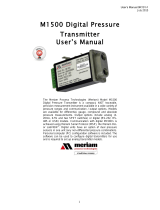
SPECIFICATIONS
Power supply
Voltage output mode (0-5v)
Voltage output mode (0-10v)
Current (4-20mA) output mode
12-30VDC/24VAC (1), 20mA max.
13-30VDC/24VAC required for 10V FS output
15-30VDC(0 ohm)/16-30VDC (250 Ohm)/
18-30VDC (500 Ohm) , 20mA max.
Outputs Switch selectable 2-wire 4-20mA, 3-wire 0-5V/10V
Operating Temperature Transmitter -22 to 158oF (-30 to 70C)
Media Compatibility Type
Temperature
Water, other 316 SS compatible media (316L diaphragm)
32 to 250oF (0-125oC)
Zero adjustment Automatic
Pushbutton, Remote zero
Press button for 5 seconds to re-zero
Hold for 10 seconds to restore factory settings
Sensor Type Micro-machined silicon strain gauge
PW Transmitter Accuracy(2)
Range according to PSID table in PW Transmitter
DIP Switch Conguration table
Sensor PSIG 2% Accurate ranges 1% Accurate ranges
25 0-1 / 0-2 PSID 0-5 / 0-10 / 0-15 / 0-20 / 0-25 PSID
50 0-10 / 0-15 PSID 0-20 / 0-25 / 0-30 / 0-40 / 0-50 PSID
100 0-15 / 0-20 / 0-25 / 0-30 PSID 0-40/ 0-50 / 0-75 / 0-100 PSID
250 0-30 / 0-40 / 0-50 PSID 0-75 / 0-100 / 0-125 / 0-150 / 0-250
PSID
500 0-75 / 0-100 / 0-125 PSID 0-150 / 0-250 / 0-500 PSID
Sensor Performance
Accuracy < +/-0.25% BFSL
Stability (1 year) +/-0.2% FS, typ
Over-range protection 200% rated pressure
Pressure Cycles > 100 Million
Compensated Range 14 to 158oF (-10-70oC)
Temperature Compensation
%FS/C
Zero, <+/-0.03(<100kPa), <+/-0.02( >100kPa)
Span, <+/-0.03(<100kPa), <+/-0.02( >100kPa)
Vibration 10G peak, 20 to 2000 Hz.
Enclosure, PW30M Construction Powder coated steel
Rating NEMA 3R
Enclosure, PW30W Construction PC/ABS
Rating NEMA 4X
Enclosure, PWT[xxx] Sensor Construction Stainless Steel, 304, 1/4” MNPT, PG9 Conduit Fitting
(1)One side of transformer secondary is connected to signal common. Dedicated transformer is recommended.
(2)Because of lower accuracy, it is not factory recommended to use an output range less that 10% of the total sensor PSIG.
Symptom Solution
No output Check wiring. Ensure power supply meets requirements
Pressure reading error Verify control panel software is congured for correct output scaling
Verify switch and jumper settings
Device will not zero Hold ZERO button for full 5-seconds until LCD blinks once
Continue holding ZERO button for 10-15 seconds, until LCD blinks twice, to restore factory settings
TROUBLESHOOTING
Issued1/6/2021 Document #152-0412-0C







